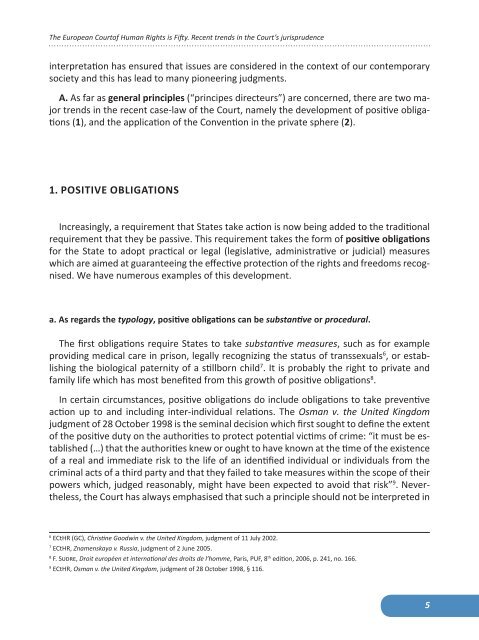Contents - Constitutional Court of Georgia
Contents - Constitutional Court of Georgia
Contents - Constitutional Court of Georgia
Create successful ePaper yourself
Turn your PDF publications into a flip-book with our unique Google optimized e-Paper software.
The European <strong>Court</strong><strong>of</strong> Human Rights is Fifty. Recent trends in the <strong>Court</strong>’s jurisprudence<br />
interpretation has ensured that issues are considered in the context <strong>of</strong> our contemporary<br />
society and this has lead to many pioneering judgments.<br />
A. As far as general principles (“principes directeurs”) are concerned, there are two major<br />
trends in the recent case-law <strong>of</strong> the <strong>Court</strong>, namely the development <strong>of</strong> positive obligations<br />
(1), and the application <strong>of</strong> the Convention in the private sphere (2).<br />
1. POSITIVE OBLIGATIONS<br />
Increasingly, a requirement that States take action is now being added to the traditional<br />
requirement that they be passive. This requirement takes the form <strong>of</strong> positive obligations<br />
for the State to adopt practical or legal (legislative, administrative or judicial) measures<br />
which are aimed at guaranteeing the effective protection <strong>of</strong> the rights and freedoms recognised.<br />
We have numerous examples <strong>of</strong> this development.<br />
a. As regards the typology, positive obligations can be substantive or procedural.<br />
The first obligations require States to take substantive measures, such as for example<br />
providing medical care in prison, legally recognizing the status <strong>of</strong> transsexuals 6 , or establishing<br />
the biological paternity <strong>of</strong> a stillborn child 7 . It is probably the right to private and<br />
family life which has most benefited from this growth <strong>of</strong> positive obligations 8 .<br />
In certain circumstances, positive obligations do include obligations to take preventive<br />
action up to and including inter-individual relations. The Osman v. the United Kingdom<br />
judgment <strong>of</strong> 28 October 1998 is the seminal decision which first sought to define the extent<br />
<strong>of</strong> the positive duty on the authorities to protect potential victims <strong>of</strong> crime: “it must be established<br />
(…) that the authorities knew or ought to have known at the time <strong>of</strong> the existence<br />
<strong>of</strong> a real and immediate risk to the life <strong>of</strong> an identified individual or individuals from the<br />
criminal acts <strong>of</strong> a third party and that they failed to take measures within the scope <strong>of</strong> their<br />
powers which, judged reasonably, might have been expected to avoid that risk” 9 . Nevertheless,<br />
the <strong>Court</strong> has always emphasised that such a principle should not be interpreted in<br />
6 ECtHR (GC), Christine Goodwin v. the United Kingdom, judgment <strong>of</strong> 11 July 2002.<br />
7 ECtHR, Znamenskaya v. Russia, judgment <strong>of</strong> 2 June 2005.<br />
8 F. Sudre, Droit européen et international des droits de l’homme, Paris, PUF, 8 th edition, 2006, p. 241, no. 166.<br />
9 ECtHR, Osman v. the United Kingdom, judgment <strong>of</strong> 28 October 1998, § 116.<br />
5






